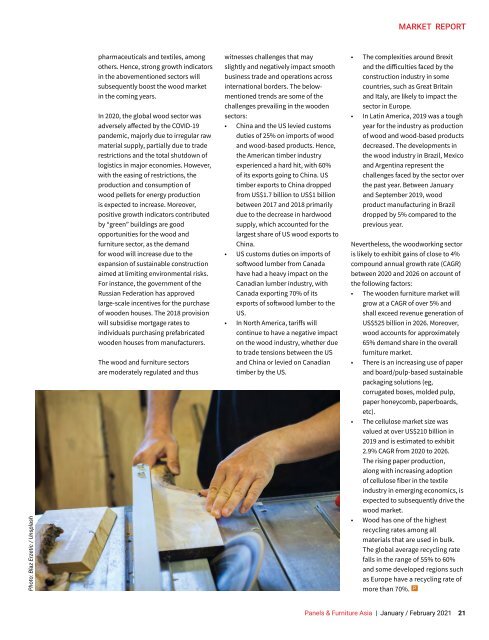Panels & Furniture Asia January/February 2021
Panels & Furniture Asia (PFA) is a leading regional trade magazine dedicated to the woodbased panel, furniture and flooring processing industry. Published bi-monthly since 2000, PFA delivers authentic journalism to cover the latest news, technology, machinery, projects, products and trade events throughout the sector. With a hardcopy and digital readership comprising manufacturers, designers and specifiers, among others, PFA is the platform of choice for connecting brands across the global woodworking landscape.
Panels & Furniture Asia (PFA) is a leading regional trade magazine dedicated to the woodbased panel, furniture and flooring processing industry. Published bi-monthly since 2000, PFA delivers authentic journalism to cover the latest news, technology, machinery, projects, products and trade events throughout the sector. With a hardcopy and digital readership comprising manufacturers, designers and specifiers, among others, PFA is the platform of choice for connecting brands across the global woodworking landscape.
You also want an ePaper? Increase the reach of your titles
YUMPU automatically turns print PDFs into web optimized ePapers that Google loves.
MARKET REPORT<br />
Photo: Blaz Erzetic / Unsplash<br />
pharmaceuticals and textiles, among<br />
others. Hence, strong growth indicators<br />
in the abovementioned sectors will<br />
subsequently boost the wood market<br />
in the coming years.<br />
In 2020, the global wood sector was<br />
adversely affected by the COVID-19<br />
pandemic, majorly due to irregular raw<br />
material supply, partially due to trade<br />
restrictions and the total shutdown of<br />
logistics in major economies. However,<br />
with the easing of restrictions, the<br />
production and consumption of<br />
wood pellets for energy production<br />
is expected to increase. Moreover,<br />
positive growth indicators contributed<br />
by “green” buildings are good<br />
opportunities for the wood and<br />
furniture sector, as the demand<br />
for wood will increase due to the<br />
expansion of sustainable construction<br />
aimed at limiting environmental risks.<br />
For instance, the government of the<br />
Russian Federation has approved<br />
large-scale incentives for the purchase<br />
of wooden houses. The 2018 provision<br />
will subsidise mortgage rates to<br />
individuals purchasing prefabricated<br />
wooden houses from manufacturers.<br />
The wood and furniture sectors<br />
are moderately regulated and thus<br />
witnesses challenges that may<br />
slightly and negatively impact smooth<br />
business trade and operations across<br />
international borders. The belowmentioned<br />
trends are some of the<br />
challenges prevailing in the wooden<br />
sectors:<br />
• China and the US levied customs<br />
duties of 25% on imports of wood<br />
and wood-based products. Hence,<br />
the American timber industry<br />
experienced a hard hit, with 60%<br />
of its exports going to China. US<br />
timber exports to China dropped<br />
from US$1.7 billion to US$1 billion<br />
between 2017 and 2018 primarily<br />
due to the decrease in hardwood<br />
supply, which accounted for the<br />
largest share of US wood exports to<br />
China.<br />
• US customs duties on imports of<br />
softwood lumber from Canada<br />
have had a heavy impact on the<br />
Canadian lumber industry, with<br />
Canada exporting 70% of its<br />
exports of softwood lumber to the<br />
US.<br />
• In North America, tariffs will<br />
continue to have a negative impact<br />
on the wood industry, whether due<br />
to trade tensions between the US<br />
and China or levied on Canadian<br />
timber by the US.<br />
• The complexities around Brexit<br />
and the difficulties faced by the<br />
construction industry in some<br />
countries, such as Great Britain<br />
and Italy, are likely to impact the<br />
sector in Europe.<br />
• In Latin America, 2019 was a tough<br />
year for the industry as production<br />
of wood and wood-based products<br />
decreased. The developments in<br />
the wood industry in Brazil, Mexico<br />
and Argentina represent the<br />
challenges faced by the sector over<br />
the past year. Between <strong>January</strong><br />
and September 2019, wood<br />
product manufacturing in Brazil<br />
dropped by 5% compared to the<br />
previous year.<br />
Nevertheless, the woodworking sector<br />
is likely to exhibit gains of close to 4%<br />
compound annual growth rate (CAGR)<br />
between 2020 and 2026 on account of<br />
the following factors:<br />
• The wooden furniture market will<br />
grow at a CAGR of over 5% and<br />
shall exceed revenue generation of<br />
US$525 billion in 2026. Moreover,<br />
wood accounts for approximately<br />
65% demand share in the overall<br />
furniture market.<br />
• There is an increasing use of paper<br />
and board/pulp-based sustainable<br />
packaging solutions (eg,<br />
corrugated boxes, molded pulp,<br />
paper honeycomb, paperboards,<br />
etc).<br />
• The cellulose market size was<br />
valued at over US$210 billion in<br />
2019 and is estimated to exhibit<br />
2.9% CAGR from 2020 to 2026.<br />
The rising paper production,<br />
along with increasing adoption<br />
of cellulose fiber in the textile<br />
industry in emerging economics, is<br />
expected to subsequently drive the<br />
wood market.<br />
• Wood has one of the highest<br />
recycling rates among all<br />
materials that are used in bulk.<br />
The global average recycling rate<br />
falls in the range of 55% to 60%<br />
and some developed regions such<br />
as Europe have a recycling rate of<br />
more than 70%. P<br />
<strong>Panels</strong> & <strong>Furniture</strong> <strong>Asia</strong> | <strong>January</strong> / <strong>February</strong> <strong>2021</strong> 21


















